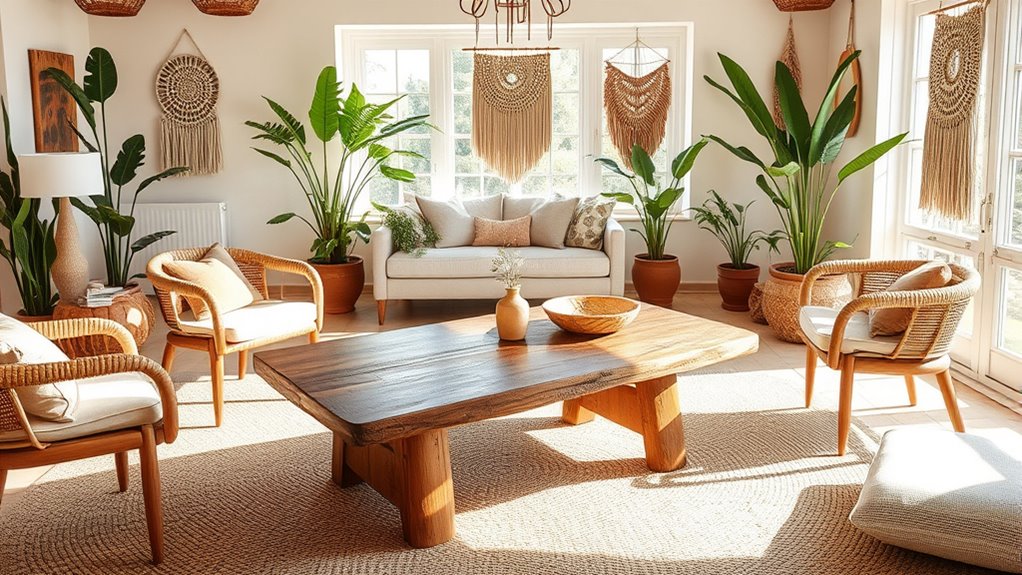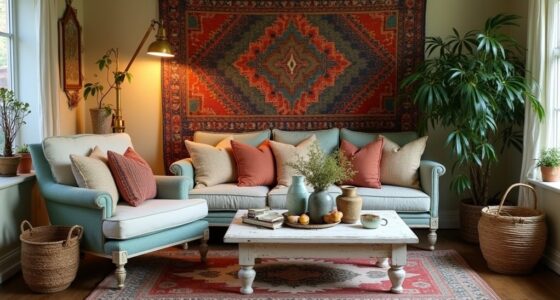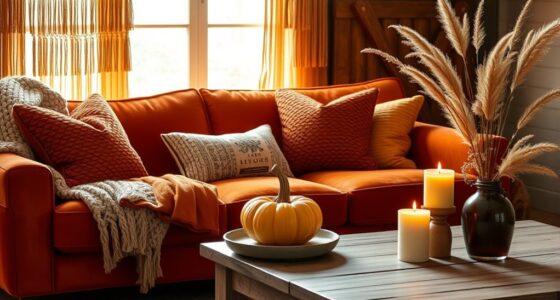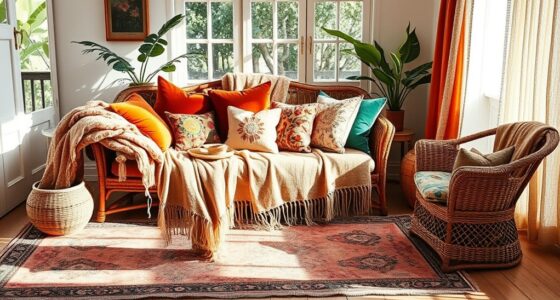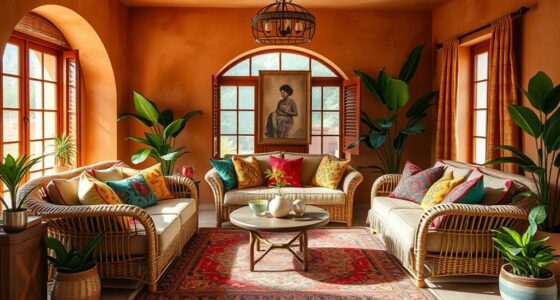To create sustainable boho interiors, incorporate reclaimed wood and natural fibers like jute, hemp, or organic cotton. These materials add character, texture, and warmth while supporting eco-conscious choices. Use reclaimed wood for furniture, wall art, or accents, and layer natural fiber textiles for comfort and visual interest. These elements foster an authentic, relaxed vibe that reflects your values. By choosing these sustainable options, you can craft a vibrant, eco-friendly space that truly feels like home—and there’s much more to explore on how to do it beautifully.
Key Takeaways
- Incorporate reclaimed wood furniture and accents to add character while supporting sustainability efforts.
- Use natural fiber textiles like jute, hemp, and organic cotton for eco-friendly, textured decor.
- Combine small reclaimed wood pieces and textiles to create a personalized, authentic boho space.
- Prioritize mindful selection of sustainable materials to reflect eco-conscious values and reduce environmental impact.
- Seamlessly blend reclaimed wood and natural fibers to craft a vibrant, eco-friendly boho interior.
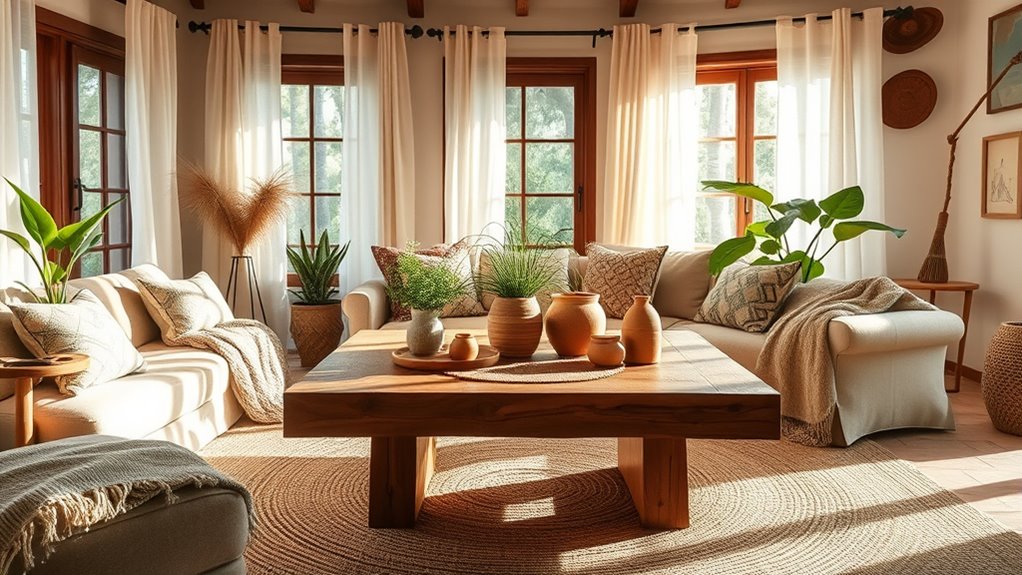
Embracing sustainable boho interiors allows you to create a stylish, eco-friendly space that reflects your free-spirited personality. You can achieve this by incorporating reclaimed wood accents and natural fiber textiles, which bring warmth, texture, and character to your home. Reclaimed wood offers a rich history and unique imperfections that no new material can replicate. By choosing furniture, shelves, or decorative pieces made from salvaged wood, you reduce demand for virgin timber and give new life to materials that might otherwise be discarded. These accents not only add visual interest but also tell a story, making your space feel thoughtfully curated and authentic.
Pairing reclaimed wood with natural fiber textiles amplifies the sustainability and coziness of your boho aesthetic. Think about using jute, hemp, or organic cotton for rugs, throws, and pillows. These textiles are biodegradable, renewable, and often produced with fewer chemicals, making them a conscious choice for eco-minded decor. Their tactile qualities add a layer of comfort and visual appeal that’s hard to match with synthetic materials. You can layer different textures and patterns to create a relaxed, inviting atmosphere that’s quintessentially bohemian.
Layer natural fibers like jute, hemp, and organic cotton for cozy, eco-friendly boho accents.
Incorporating reclaimed wood accents doesn’t mean you have to overhaul your entire space. Small touches, like a reclaimed wood coffee table or wall art, can make a significant difference. These elements ground your decor and serve as focal points that highlight your commitment to sustainability. Likewise, natural fiber textiles can be integrated through curtains, upholstery, and accessories, helping to soften the look and introduce organic textures. Mixing and matching these materials ensures a cohesive yet eclectic vibe that’s both stylish and eco-conscious.
Using reclaimed wood and natural fibers also encourages a more mindful approach to decorating. Instead of impulsively filling your space with mass-produced items, you carefully select pieces that contribute to a sustainable lifestyle. This mindset not only benefits the environment but also makes your home feel more personalized and meaningful. Every piece becomes a reflection of your values and aesthetic preferences, fostering a deeper connection to your surroundings.
Ultimately, sustainable boho interiors thrive on authenticity and eco-awareness. By choosing reclaimed wood accents and natural fiber textiles, you create a space that’s visually appealing, environmentally responsible, and perfectly aligned with your free-spirited nature. These elements work together to craft a home that’s stylish, sustainable, and full of life, inviting you to relax and enjoy your thoughtfully curated sanctuary. Incorporating eco-friendly materials enhances your decor’s sustainability and helps reduce the environmental impact of your interior design choices.
Frequently Asked Questions
How Do Reclaimed Wood Finishes Impact Indoor Air Quality?
Did you know that reclaimed wood emits up to 80% fewer VOCs than new wood? Reclaimed wood finishes can markedly improve indoor air quality by reducing indoor air pollutants and minimizing VOC emissions. When you choose reclaimed wood for your interiors, you’re not only embracing sustainability but also creating a healthier environment. This choice helps lower airborne toxins, making your space safer and more comfortable for everyone inside.
What Are the Best Natural Materials for Sustainable Boho Decor?
You should choose eco-conscious textiles like organic cotton, hemp, or linen for sustainable boho decor, as they’re renewable and breathable. Incorporate sustainable lighting options such as solar-powered lamps or LED fixtures to reduce energy use. These natural materials and eco-friendly lighting not only enhance your space’s aesthetic but also support environmental health, creating a cozy, stylish, and responsible boho vibe that aligns with your eco-conscious values.
How Can I Identify Authentic Reclaimed Wood?
You can identify authentic reclaimed wood by checking for reclaimed wood certification labels or marks, which prove its origin and sustainability. Look closely for signs of authenticity verification, such as unique grain patterns, weathered textures, and aged patina—these tell a story of history and reuse. Don’t forget to trust reputable suppliers who provide documentation, ensuring your reclaimed wood genuinely supports eco-friendly practices and adds genuine character to your boho space.
Are There Eco-Friendly Alternatives to Traditional Dyes and Paints?
Yes, there are eco-friendly alternatives to traditional dyes and paints. You can opt for eco-friendly dyes made from natural pigment options like plant extracts, minerals, or flowers, which are safer for the environment. These natural pigments are non-toxic, biodegradable, and often require less energy to produce. Using them can help you create beautiful, sustainable boho interiors that are both stylish and eco-conscious.
What Maintenance Is Required for Natural Material Furniture?
Think of your natural material furniture as a garden needing gentle care. You’ll want to establish simple cleaning routines, like wiping with a damp cloth to keep dust at bay. Seasonal care means adjusting your approach—perhaps applying natural oils in dry months or shielding pieces from direct sunlight. Regular, mindful attention keeps your furniture vibrant, much like tending a lush, thriving landscape that tells your story of sustainability.
Conclusion
As you embrace sustainable boho interiors, you realize how beautifully reclaimed wood and natural materials reflect your values. Every piece you choose not only adds warmth and character to your space but also connects you to a mindful way of living. It’s a coincidence, really—how the simple act of selecting eco-friendly decor can transform your home into a sanctuary of both style and purpose. In this harmony, you find beauty, balance, and a deeper sense of belonging.
